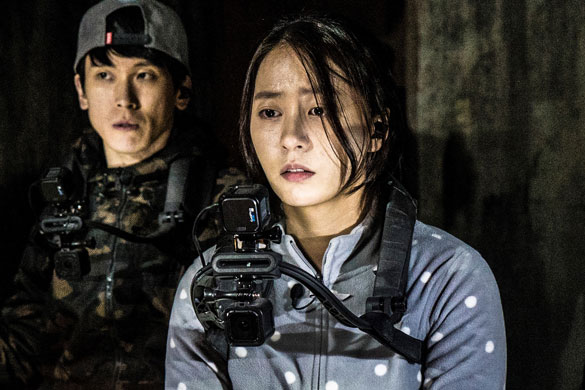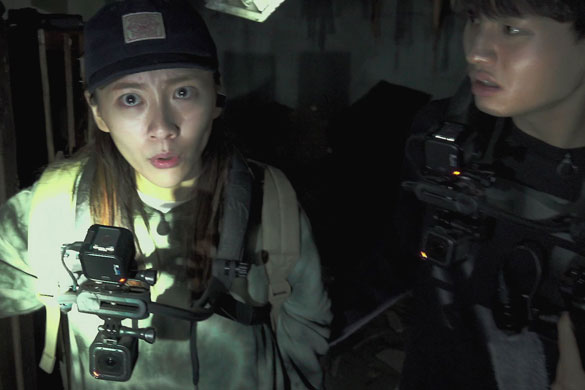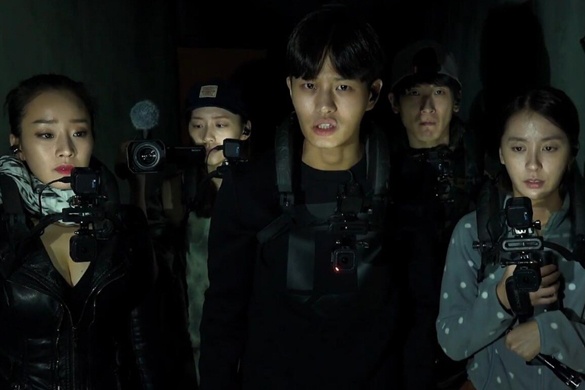"I shouldn't have written my name on the wall. I'm cursed now...
Did you see? The words under my name changed from ‘Let's live’ to ‘Let's die’. Am I going to die?..."
Synopsis:
After two youths go missing while breaking and entering into Gonjiam asylum – a mental institution that closed more than 20 years previously when the patients/inmates were found dead and the female director went missing, never to be seen again – a mobile phone video of the young boys' fateful ghost adventure appears online, instantly going viral. Seeing the video’s huge and increasing popularity and instantly equating it to advertising profits, the makers of paranormal programme Horror Times decide to hold a live streaming, audio-visual ghost investigation at Gonjiam, the culmination of which will be an attempt to break into room 402; a room said to bring death to anyone even trying to open its door.
As the investigation gets underway, strange banging sounds, sudden slamming doors and the like soon give way to far darker unexplained occurrences and with the investigators’ nerves increasingly fraying to almost breaking point the question quickly becomes whether this seemingly paranormal activity is ultimately set-up fakery, hysteria-induced imaginings or truly the spirits of the dead on a bloody quest for vengeance?...
Review:
In the years since The Blair Witch Project and the like exploded onto the international film stage, interest in the found footage horror sub-genre has waxed and waned with narratives gradually moving from innovative and highly original to largely generic to the extent that viewers, certainly in the West, are likely to demand something new to be added to the found footage idea before interest can be truly sparked.
During the same period, Korean cinema has largely stayed away from found footage horror and though, for example, director Oh In-chun in 2017 created the wholly independent Wol-ha : Very Bad Moon Rising (월하), larger studio-released Korean found footage horror films are virtually non-existent; or they were until Showbox gave the green light for Gonjiam.
As such, if we consider Korean cinema only and specifically, Gonjiam could almost be considered as one of the first few steps into a virtually new sub-genre for K-horror and that being the case I for one was far less preoccupied with whether director Jung Bum-shik brought any genre innovation than I was with hoping he’d use the tropes found footage affords effectively enough to produce a genuinely scary tale. So, was that ultimately the case? Read on, dear reader, read on:
 |
Gonjiam begins with the cell phone footage of the two youths’ fateful, and indeed fatal, ghost hunt at the asylum. This is essentially the only true found footage segment of the film and that to my mind is a wise decision on the part of director Jung Bum-shik; his choice of making the main narrative a live streaming video event allowing a couple of issues that haunt found footage horror (if you'll allow me that terminology) to be dealt with in a far more believable manner than is largely the norm:
Firstly, the live streaming gives a legitimate reason for the creation of the video and negates any need for twisted, convoluted exposition as to where the investigators’ filmed footage suddenly and inexplicably appeared from. Secondly, in order to professionally film the Horror Times investigation, the various individuals involved have GoPro cameras harnessed to their bodies (filming both a POV view and a view of the investigator’s face virtually full frame) so the filming can and will continue whatever befalls them. I've lost count of the number of found footage horrors where a character in absolute peril continues to film with a handheld camera, even in the midst of running (or fighting) for their life, leaving me constantly thinking “Really??!!?? Commendable, I guess, but wouldn't you really just drop the camera and get the hell out of there?”. The harnessing of the cameras in Gonjiam easily, instantly and effectively addresses that issue in a wholly natural manner, and that in itself is a huge plus point for both story and film.
Following brief, supposedly archive footage of the asylum’s director carrying out her duty of care – indeed, receiving an award for doing so – and an introduction by Horror Times’ lead investigator Ha-joon (Wi Ha-joon) into the forthcoming investigation as well as the various myths and legends that surround Gonjiam, we are taken to two days before the ghost hunt begins to be introduced to the various investigators. This and the team's subsequent journey to Gonjiam would sit perfectly alongside any opening of a myriad of classic horrors in which a group of young people go on a supposedly fun-filled journey unaware of horrors that await them, and as such it comes across as wholly familiar and indeed feels like it totally belongs. This character introduction is also rife with genuine humour and witty banter, allowing viewers to both warm to the characters and get an idea of their individual personalities and how they interact, which will become vitally important to proceedings once darkness begins to fall, as it were.
 |
Once the investigation gets underway, it isn't long before strange noises, unexplained banging doors and the like begin to abound but the most important aspects here are the things characters and viewers alike have seen but aren't wholly sure they've seen: Was a doll that belonged to a patient really situated in a cabinet before being found on a shelf across the room; was there really a strange dark anomaly on the video footage shot by one of the investigators or was it just a technical hitch; and did the Korean words written below Charlotte’s name really change from “Let's live” to “Let's die”? These moments perfectly raise the question of whether we (and indeed the characters) can really believe what we/they think we've seen and deftly underline the idea of fear being driven by perception as much as fact, which is wholly necessary to the believability of the hysteria building in the characters’ minds. This (wholly palpable) hysteria forms the backbone (if you will) of the seemingly paranormal activity taking place for just over half the film's running time, ramped up to almost rollercoaster ride levels by the intrusive, deeply claustrophobic GoPro views on the panic-stricken characters’ faces, full frame. This builds yet further in tandem with a quickening of pace and an increase in the ferocity of the ghostly encounters ensuring that Gonjiam is regularly exhilarating, often deeply creepy and more often than not genuinely horrifically scary.
However, no sooner will viewers try to take a breath to continue to figure out whether what the characters face is set-up fakery, wholly hysteria-induced imaginings or truly paranormal activity than they will discover that the horrors at Gonjiam have truly only just begun.
As a final note, the use of Gonjiam mental asylum as the setting for the film was a frankly inspired decision: Gonjiam was indeed a real-life mental institution which was closed when several patients died and sanitation issues took hold, and though Jung Bum-shik's narrative is a huge embellishment of the truth based on a myriad of spooky myths that have circulated over the years, those legends ultimately started with at least a grain of fact. Gonjiam is now so run down that it has become known as a truly ominous place, to the extent that it was even listed by the CNN news channel as one of the ‘freakiest places’ on earth ( http://travel.cnn.com/freakiest-places-around-world-681626/).
As such, any horror film set in such a genuinely creepy building could almost be guaranteed to succeed in chilling the bones, and succeed Gonjiam: Haunted Asylum certainly does.
Summary:
Gonjiam: Haunted Asylum is ultimately a worthy Korean entry into the found footage horror sub-genre. Regularly exhilarating, often deeply creepy and sometimes genuinely scary, Jung Bum-shik's narrative may not bring anything new to the table particularly but it does at least address several issues virtually inherent to found footage horrors over the years.
GONJIAM: HAUNTED ASYLUM (곤지암) / 2018.
Director: Jung Bum-shik
Starring: Park Ji-hyun, Wi Ha-joon, Oh Ah-yeon, Moon Ye-won
|




